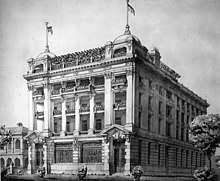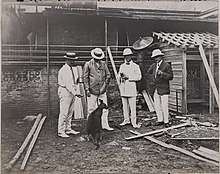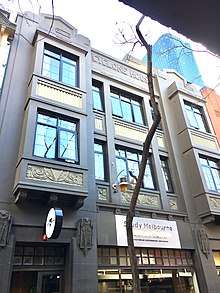Arthur Purnell
William Arthur Purnell F.R.A.I.A. (5 January 1878 – 29 June 1964), generally known as Arthur Purnell, and sometimes A W Purnell, was an Australian born architect who practiced in Canton, China in the 1900s, and from 1910 mainly in Melbourne, Australia. He is most noted for the few designs in Melbourne that include Chinese references.
Early history
Arthur Purnell was born in 1878 the eldest son of William Purnell, jun., and his wife Emily, née Keown of Geelong, Victoria. He was educated at McManus Preparatory School, Flinders State School, Geelong College, then studied architecture at Gordon Technical College, and drawing at the Geelong School of Arts. His father and grandfather were partners in Purnell & Sons, builders, and Arthur joined the firm as a draftsman in 1895, then took further studies under C. A. Heyward, a government architect.[1]
The China years
In 1900 Purnell left for China, and established himself in Canton (modern Guangzhou) in 1903. In 1904 he teamed up with Charles Souders Paget (1874–1933), a civil engineer from Bethlehem, Pennsylvania, as Purnell & Paget, winning the competition for a new Customs House the same year, and they soon developed a busy practice. They designed numerous projects, including large buildings for the Chinese Imperial Post Office, the London Missionary Society, the Canton Christian College, the Southern Baptist Theological School, and a power station for China Light & Power,[2] which have all been demolished as Guangzhou has been redeveloped in recent years.

The former British and French concession Shamian Island (then known as Shameen) however is completely intact, and hosts a number of designs by the firm, as well as alterations such as extra floors.[3] They include the Imperial Maritime Customs Building (eastern end of Central Shamian Street on the north side, with a pair of 'witches hat' towers, 1907), Griffith & Co (south west corner of North Shamian and Third Streets, c1905), Karberg & Co, (50 South Shamian Street, 1908),[4] International Banking Co (end of Central Shamian on the north side, 1908), Deacon & Co (northwest corner of Central Shamian and Fifth, 1908).[2] All of the designs were generally in the Far East British Colonial form known as 'compradoric', featuring multi-level verandahs supported on solid pillars or arches, with Italianate or Edwardian Baroque detailing.
One of his designs outside Shamian to survive is the South China Cement Factory built in 1909, which was later used by Chinese Nationalist leader Sun Yat-sen as his home and headquarters from 1917-1923, and is now a museum.[2][5]

He returned briefly to Melbourne in 1908 to marry Jane Farrell. Her parents were pastoralists from Lake Monemia near Streatham, Victoria.[6] He returned to Canton with his new wife and a pet Kangaroo and joey, as seen in a photo from 1908.
Return to Melbourne
Purnell returned to Melbourne in 1910, and set up office in the Nicholson Chambers at 101 Swanston Street, and later Phair's Buildings at 327 Collins Street.
A notable design of this time was Michael's Corner, built in 1915, which still stands on the south west corner of Elizabeth and Lonsdale Streets.[7]
During this time and into the 1920s he did many designs for people and businesses of Chinese origin, while a few designs of is own contained elements of Chinese design, or featured Chinese names. For instance he designed a warehouse in Melbourne's Chinatown in Punch Lane off Little Bourke Street in 1911 for cabinetmaker Tye Shing (demolished). His own house of 1916 (demolished)[8] was an early example of the Bungalow style, with exaggerated verandah piers and projecting chimney pots with a slightly Oriental character,[9] which he named Shameen in a clear reference to this time in China.
Clearer use of Chinese design motifs can be seen an unbuilt tearoom design for Malvern in 1913 which featured a distinctly Oriental roof and verandah, followed by ‘Tsohshaan Mansions’ (‘tsohshaan’ is supposedly Cantonese for ‘house upon the hill’), at the corner of Malvern and Irving Roads Toorak, built 1917, which has an Oriental feel achieved without overt Chinese elements.[10][11] In 1928 he designed another teahouse, at 22 Newcombe Street Portarlington (demolished), which featured a distinctly Chinese roof shape.[12]
His most well known Chinese influenced design, and possibly the best known of all his works, is his own house, located on a busy city artery, at 492 Punt Road South Yarra. This is a substantial reworking of a house he had designed for his client "Alec" Barlow in 1924, which he bought and named Shan Teng, adding a number of rooms, changing the orientation, and in particular the roof, which he changed just before construction from a simple hipped roof to one with a curved Chinese shape.[13][14] His daughter recalled that the family had Chinese servants indentured from an American ships captain.[2]
Beaver and Purnell

In 1915 he joined with Isidor Beaver at his practice at Altson's Buildings, 82 Elizabeth Street, Melbourne, on the Collins Street corner. Beaver was a Manchester-born architect who had been in partnership with Edmund Wright in Adelaide and moved to Melbourne in 1890 to supervise construction of their National Mutual Life building on the corner of Collins Street and Queen Street.
A notable project by the firm was the well known St. Moritz Ice-skating Palais, a 1939 conversion of their 1922 Wattle Path Palais de Danse, a large arched roofed dance hall on the Esplanade at St. Kilda, controversially demolished in 1982.
Purnell left the partnership in 1925; Beaver, 19 years his senior, died in 1934.
Project include :
After Beaver

Purnell moved to offices in the Equitable Building at 314 Collins Street. In 1928 he briefly formed a partnership with Eric Hazel Round and William Alfred Graham as Arthur W. Purnell, Round & Graham, which only lasted only a year, and he went into solo practice again. In 1935 that he formed A. W. Purnell & Pearce, with Phillip Foster Pearce A.R.A.I.A., still at the same address.[17] By the time Pearce retired in 1946, their offices were at the Colonial Mutual Life building in Collins Street, the same building by a different name.[18]
As well as a great number of private residences in a multitude of styles, works produced during this time include a wide range of commercial projects, mostly now demolished:
- Clifton Springs Golf Club (1926)
- A greyhound-racing track at Tottenham (1927, demolished)[19]
- Regent Theatre, Ballarat, with Cedric Ballantyne (1927)[20]
- A grandstand at Western Oval (now Whitten Oval) (1929, extensively altered)
- Woolstore No 2, Younghusband Woolstore, Kensington (1928 + 1932)[21]
- Cyclone House, Hardware Street, Melbourne (1930)[22]
- Patersons Furniture Store, 152 Bourke Street (1934)[23]
- Younghusband Woolstore, Albury (1936, demolished)[24]
- The Olympia Sea Water Swimming Pool at South Melbourne (1937, demolished)
- Southern Stand, Melbourne Cricket Ground (1937, demolished)[25]
- The Rosebud Yacht Club (1939, demolished)
- Glaciarium, South Melbourne, interior remodelling (1939, demolished)[26]
- Avonmore Lodge (maisonettes), Toorak Road, cnr Glenferrie Road, Toorak, 1940[27]
- The Olympic Stand at the Melbourne Cricket Ground (1953–1955, demolished).
In the 1920s Purnell had a close working relationship with car dealer Alexander George "Alec" Barlow (1880–1937), for whom he built a home, car showrooms and racing stables.[28] Purnell's own house on Punt Road was a reworking of an earlier house he had designed for Barlow, who had to sell up.[29]
Family
William Arthur Purnell married Jane (aka Ginnie) Farrell, near Streatham, Victoria in 1908; Ginnie died on 25 October 1966. The hot humid climate of Southern China did not suit Ginnie and may have been the reason they returned to Australia in 1910. Their only child, a daughter Joan, was born in 1918, ten years after their marriage. In 1923 they divorced, but three years later they remarried. Joan Margaret Purnell married Noel William Dickson in 1939, and died in 2002.[2]
Further reading
- Groves, Derham, From Canton Club to Melbourne Cricket Club:The Architecture of Arthur Purnell, Exhibition Catalogue, Melbourne University, 2006.
- Melbourne University Archives has several thousand drawings, correspondence etc. Archives Catalogue entry here.
- Culture Victoria entry for Arthur Purnell found here.
References
- "The architecture of Arthur Purnell: personal life and education". Culture Victoria. Retrieved 14 December 2015.
- Purnell, Arthur; Groves, Derham; Allison, Brain; University of Melbourne; Library (2006). From Canton Club to Melbourne Cricket Club: the architecture of Arthur Purnell. Melbourne: Baillieu Library. ISBN 9780734036704. OCLC 137332833.
- "The architecture of Arthur Purnell: Purnell in China". Culture Victoria. Retrieved 14 December 2015.
- A photo can be found here
- "Memorial Museum of Generalissimo Sun Yatsen's Mansion | Guangzhou, China Attractions". www.lonelyplanet.com. Retrieved 18 August 2019.
- "Personal life and education - The Architecture of Arthur Purnell". Culture Victoria. Retrieved 19 August 2019.
- "Michael's Corner". Victorian Heritage Database.
- "Shameen". Victorian Heritage Database.
- "Shameen, Malvern, 1916 - The Architecture of Arthur Purnell". Culture Victoria. Retrieved 19 August 2019.
- "Tsohshaan Mansions in 2005 - The Architecture of Arthur Purnell". Culture Victoria. Retrieved 18 August 2019.
- "Tsaohshaan Mansions". Victorian Heritage Database.
- "Arlington Café, 1928 - The Architecture of Arthur Purnell". Culture Victoria. Retrieved 19 August 2019.
- "Shan Teng, South Yarra, 1928 - The Architecture of Arthur Purnell". Culture Victoria. Retrieved 18 August 2019.
- "Barlow Connection and Later Projects - The Architecture of Arthur Purnell". Culture Victoria. Retrieved 19 August 2019.
- "Ramnoor". Victorian Heritage Database.
- Hubbard, Timothy; Tribunal, Victoria Administrative Appeals (1992). Planning appeal no. 1992/016225, Carinya, 61 Clendon Road, Toorak : submission to the Administrative Appeals Tribunal for a hearing on 19 August 1992 [...]. St. Kilda, Vic. : Timothy Hubbard Pty Ltd. ISBN 9781875224630.
- "New Architectural Firms". The Argus. Melbourne. 11 July 1935. p. 13. Retrieved 15 December 2015 – via National Library of Australia.
- "Advertising". The Argus. Melbourne. 22 November 1946. p. 17. Retrieved 15 December 2015 – via National Library of Australia.
- "Photographs - WHITE CITY - Victorian Collections". victoriancollections.net.au. Retrieved 19 August 2019.
- "Regent Theatre Ballarat". Victorian Heritage Database.
- "Big Extensions To Woolstore". Herald (Melbourne, Vic. : 1861 - 1954). 29 June 1932. p. 13. Retrieved 19 August 2019.
- "GENERAL". Construction and Local Government Journal (Sydney, NSW : 1913 - 1930). 5 March 1930. p. 8. Retrieved 6 October 2019.
- "Bourke Street Firm Rebuilds". The Herald (17, 677). Victoria, Australia. 10 January 1934. p. 17. Retrieved 19 August 2019 – via National Library of Australia.
- "Wool Store Designed For Expansion". Herald (Melbourne, Vic. : 1861 - 1954). 26 August 1936. p. 20. Retrieved 3 September 2019.
- "NEW STAND FOR MELBOURNE CRICKET-GROUND". The Argus (Melbourne) (27, 873). Victoria, Australia. 19 December 1935. p. 14. Retrieved 19 August 2019 – via National Library of Australia.
- "New Glaciarium Opens 1939 Season". The Herald (19, 302). Victoria, Australia. 29 March 1939. p. 21. Retrieved 19 August 2019 – via National Library of Australia.
- "ARCHITECTURE MAISONETTES POPULAR INVESTMENTS". Argus (Melbourne, Vic. : 1848 - 1957). 9 May 1940. p. 15. Retrieved 3 September 2019.
- "The architecture of Arthur Purnell: career and practice". Culture Victoria. Retrieved 14 December 2015.
- "A.G. Barlow's house, South Yarra, 1924 - The Architecture of Arthur Purnell". Culture Victoria. Retrieved 19 August 2019.
Garton Family Book 2018 The Argus 29 November 1923